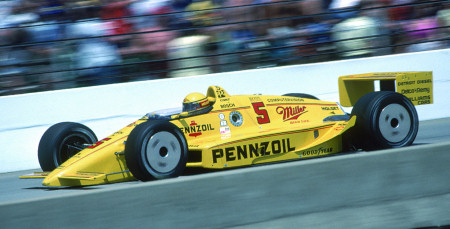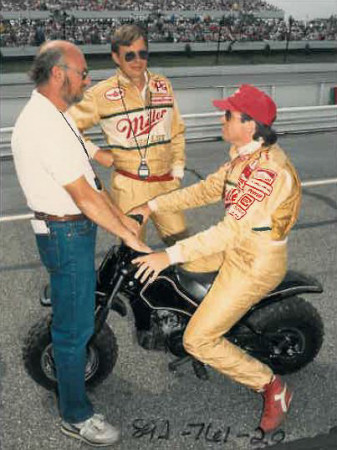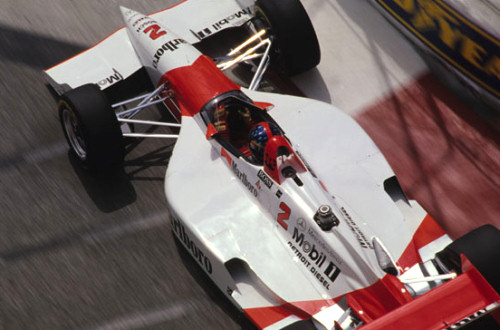The Way It Is/ Nigel Bennett's solutions for F1 & IndyCarby Gordon Kirby |
 Nigel Bennett enjoyed a long career designing Formula One and Indy cars. He started his career in the seventies as a Firestone tire engineer in Formula One and worked at Lotus, Ensign and Theodore before turning his hand to Indy cars with Lola. After producing a few successful Lola Indy cars, Bennett was hired by Roger Penske and through the late eighties and nineties he designed a series of beautiful and very successful Penske Indy cars.
Nigel Bennett enjoyed a long career designing Formula One and Indy cars. He started his career in the seventies as a Firestone tire engineer in Formula One and worked at Lotus, Ensign and Theodore before turning his hand to Indy cars with Lola. After producing a few successful Lola Indy cars, Bennett was hired by Roger Penske and through the late eighties and nineties he designed a series of beautiful and very successful Penske Indy cars.
A longtime boating and yachting enthusiast Bennett does some boat design work these days to keep him occupied in his retirement. He's also kept his hand in the racing business in recent years by doing some technical consulting work for the FIA and after reading last week's column, ‘Losing our way', Nigel sent me an email saying he had some suggestions for improving the show in F1 and IndyCar. I called him and we enjoyed a pleasant chat about the state of the sport. "I think Formula One does a good job with the television commentaries here in the UK and the build up to each race," Bennett remarked. "They've got informed, experienced guys who are past drivers and team owners and provide you with lots of good information and they do it in an entertaining way.  © Bob Tronolone Bennett emphasized that extreme cost is F1's biggest problem. "The main problem with Formula One is that it's just too expensive for all but about four teams," he said. "The rest of them are taking paying drivers who are less skilled than many others. There are some really good drivers like Hulkenberg and di Resta who may not have drives next year. "I have to say that what goes on inside some of these big teams is absolutely ludicrous. There are drawing offices going off into the distance as far as you can see with eighty or ninety people working away at computer screens. "The cars are incredibly complicated. They're beautifully made but unbelievably complicated with all kinds of stuff that's largely unnecessary and unappreciated by the fans and media. It makes for paying jobs for the young engineers but as far as the general public is concerned I don't think there's much interest in that. "Look at the front wings with all the little bits and pieces stuck on them. And for what? Yes, they're producing phenomenal aerodynamic performance figures but none of that stuff bares any relation to anything else in the world and it doesn't look nice. "Airplanes don't have bits like that stuck all over them. They're sleek, the way racing cars used to be, and there's no place for that kind of stuff on road cars. It's just jobs for the boys to spend the money they've been given." Bennett believes big cuts in downforce and tire grip are essential to making F1 a better show.  Kirby, Bennett & Danny Sullivan, Pocono 1989 © Racemaker/Torres "I suspect this would mean going back to bias or cross-ply tires as they were in the ‘70s and ‘80s. So what if that is not the way road car tires are made? Road cars are completely different from racing cars in so many ways. You still wouldn't see the driver's arms flailing around but the driver's skill would be on view as the cars would drift and braking distances would be much longer and cornering speeds much lower so that overtaking would be more frequent. "Right now, the braking distances are so short and the cornering speeds are so high that there's just no time to outbrake the other guy. So a huge reduction in downforce and a similar, huge reduction in tire performance is required. If you had half the size of front tire you wouldn't be able to brake so hard in such a short distance. "I think the reason the cars used to be so much more spectacular was largely due to the type of tires. Cross-ply tires made for bigger slip angles and more sliding than we have today with radial tires. "People say we can't go back to cross-ply tires, but why not? If you have one tire manufacturer you can ask them to do anything. Formula One persuaded Pirelli to build tires that wear out after ten laps, which is not good for their public image. But that's what Formula One wanted and that's what Pirelli have done. So surely you can ask a tire company to build smaller, cross-ply tires. "I'm sure they've got the technology to do it and the cars would be more spectacular to watch. I would also suggest they would be a greater test of the drivers' skills." Bennett believes narrower tires also would be a benefit to IndyCar. "There's been a lot of criticism over recent years about Indy cars having too much downforce and too little power so that they run closely together on some tracks so you get pack racing which is very dangerous on a track where they're flat-out all the way around whether it's a one-mile oval or a banked track like NASCAR. "To me, a reduction in tire size would be very effective for IndyCar in these circumstances. The cornering speeds would be less, the straightaway speeds would be greater and at a stroke it would break up the field and allow it to open up a bit so there would be more passing and racing. "If you reduce the tire sizes by fifteen percent then the compounds have to get harder to withstand the temperature. Straightaway speeds would go up because the drag would be reduced and you would get braking into the corners because the apex speed would be lower. It's one way out of this problem that's never been suggested."  © Paul Webb "I'm glad they're getting rid of the high noses next year because they look pretty stupid," he remarked. "That's a step in the right direction, but they need to reduce downforce substantially. "It's easy to design a set of rules to achieve that, but it's not easy to get people to agree. They've all invested millions of dollars in wind tunnel testing and aerodynamic work and they don't want to lose the advantages they've gained. "They've talked endlessly for some years about cost reduction but that seems to have fallen by the wayside. In fact, I've been involved in some of those discussions and the problem is nobody trusts anybody else to do it properly. "Until the governing body comes up with some way of controlling budgets there's not going to be any changes. If you stop them spending money in one area then they'll spend more on their motorhomes and marketing. Do you need fifty or sixty people per team at the racetrack? Or a dozen trucks, like McLaren takes to a race?" Bennett believes next year's new turbo formula will prove to be very costly. "It sounds like the engine package is going to be very expensive next year," he observed. "It looks like the split between the haves and the have nots is going to become even bigger." I mentioned to Bennett that Adrian Newey remarked to my colleague Maurice Hamilton a few weeks ago that he was worried that next year's new F1 cars will be even uglier than this year's cars. "It's funny how you very quickly get used to something new and different," Bennett remarked. "When they brought in narrow rear wings and wider front wings to F1 everyone said they looked ugly and worried about it. But they seem to have grown on everyone and nobody complains so much anymore, although the front ends are pretty ugly." Bennett doesn't expect anyone in F1 or the FIA to act on any of his suggestions. "I don't suppose that whatever we say will have much effect," he chuckled. "One thing I found with the FIA is they say we can't change Formula One too much because GP2 or Formula Renault will then be too quick. It seems to me that the FIA doesn't have the guts to make big decisions or maybe it's because the teams have got too much say over what they've invested. They have to get unanimous agreement among the teams to make any big changes and they can't get it." Power and political struggling always come first in big-time motor racing, ahead of rational thinking. Thus it ever was and is likely to continue. |
Auto Racing ~ Gordon Kirby Copyright 2013 ~ All Rights Reserved |
